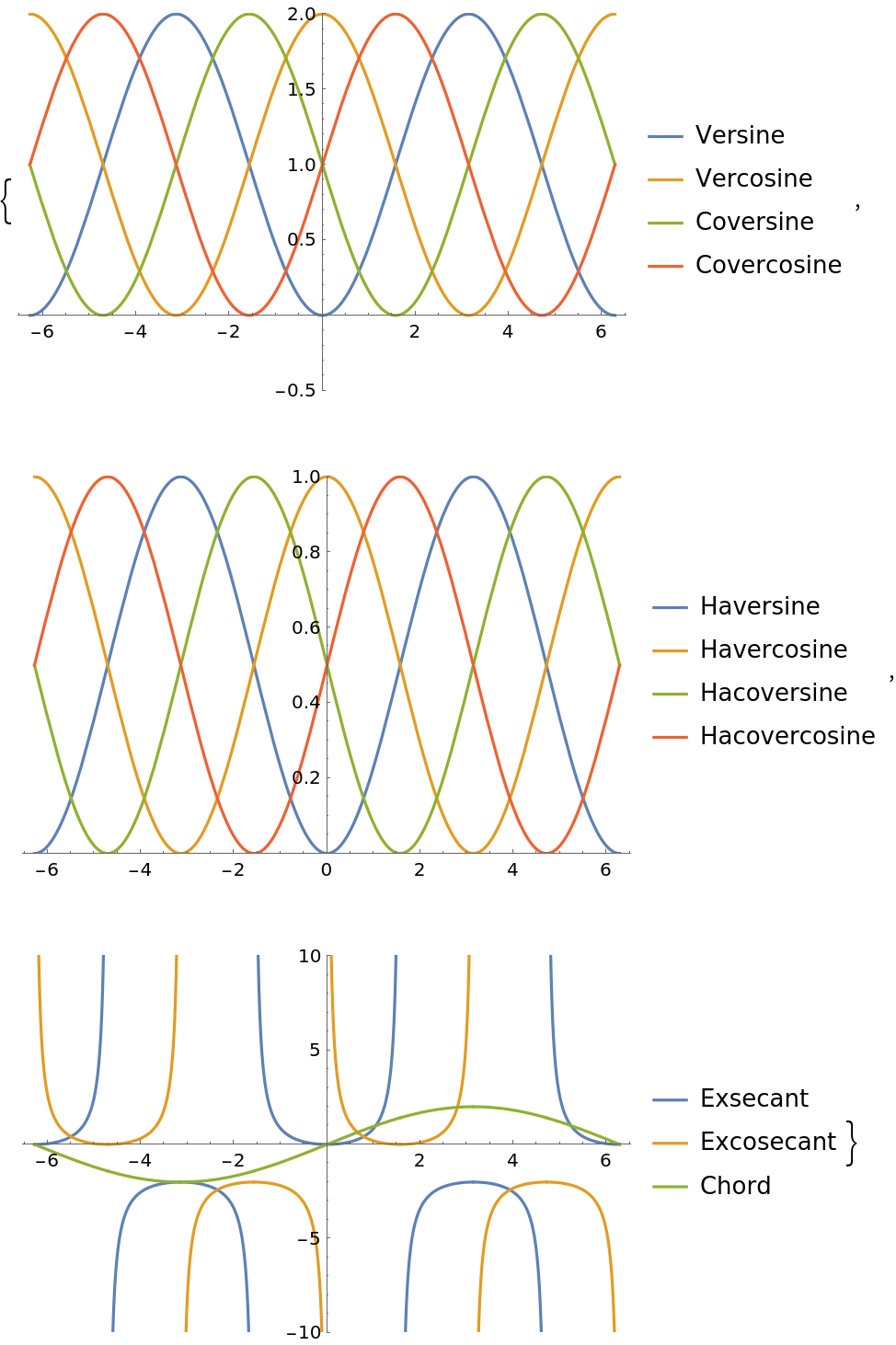Wolfram Language Paclet Repository
Community-contributed installable additions to the Wolfram Language
A collection of lesser-known circular and hyperbolic trig functions and their inverses
Contributed By: Christopher Stover
In a standard trigonometry course, we typically learn about six functions (and their inverses): sin(x), cos(x), tan(x), csc(x), sec(x), and tan(x); this may or may not be extended later to cover the six hyperbolic trig functions (e.g. sinh(x)) and/or their inverses (e.g. sin-1(x), sinh-1(x)).
A less-known fact is that trigonometry actually consists of over two dozen other circular and hyperbolic functions, each of which has a well-defined inverse. These mysterious trig functions are closely related to the more well-known relatives that we all know and love today, and though they're rarely used, these functions were ubiquitous a few centuries back, being employed both in academia and in various applications (e.g. mapmaking, ocean exploration, etc.).
Mathematica has a couple of these little-used trig functions built in (namely Haversine and InverseHaversine), but the rest remain unrepresented; this absence is the underlying motivation for Trigonometry. All of the 50+ functions in Trigonometry work naturally with the entire Wolfram Language framework, and their immediate availability allows a better understanding of the relationships and history of both trigonometry and mathematics as a whole. These functions provide both a learning opportunity and a teaching tool, thus contributing to the enrichment of mathematics as a whole.

To install this paclet in your Wolfram Language environment,
evaluate this code:
PacletInstall["TheRealCStover/Trigonometry"]
Evaluate numerically:
| In[1]:= | ![(* Evaluate this cell to get the example input *) CloudGet["https://www.wolframcloud.com/obj/f5599365-b686-420d-bc66-19d461645120"]](https://www.wolframcloud.com/obj/resourcesystem/images/d91/d914e9d4-2be0-4478-8342-578434d19777/1-0-7/18db638d971b88fc.png) |
| Out[1]= |
An argument given in radians:
| In[2]:= | ![(* Evaluate this cell to get the example input *) CloudGet["https://www.wolframcloud.com/obj/00390dd9-9cba-413c-b22d-fc6fc38844cf"]](https://www.wolframcloud.com/obj/resourcesystem/images/d91/d914e9d4-2be0-4478-8342-578434d19777/1-0-7/376a082cb571c4e3.png) |
| Out[2]= |
Use Degree to specify an argument in degrees:
| In[3]:= | ![(* Evaluate this cell to get the example input *) CloudGet["https://www.wolframcloud.com/obj/6b54b898-5652-46bf-a71d-8ae779e4a235"]](https://www.wolframcloud.com/obj/resourcesystem/images/d91/d914e9d4-2be0-4478-8342-578434d19777/1-0-7/55acab91b568997b.png) |
| Out[3]= |
Plot over a subset of the reals:
| In[4]:= | ![(* Evaluate this cell to get the example input *) CloudGet["https://www.wolframcloud.com/obj/4ae01c45-7947-4c33-a77f-42c5d999fd9e"]](https://www.wolframcloud.com/obj/resourcesystem/images/d91/d914e9d4-2be0-4478-8342-578434d19777/1-0-7/2b130bb792bb5118.png) |
| Out[4]= |  |
Wolfram Language Version 13